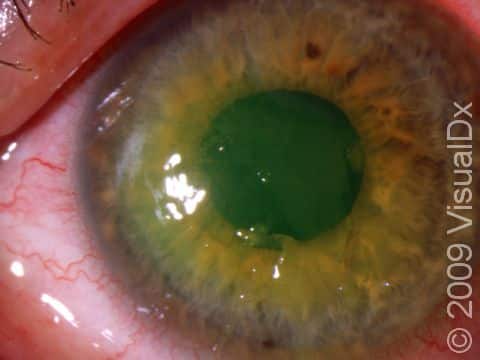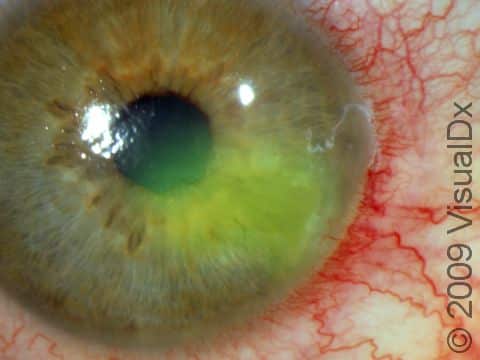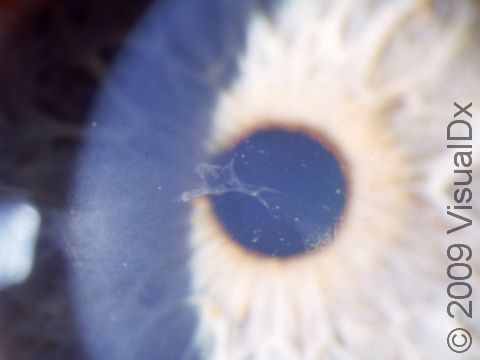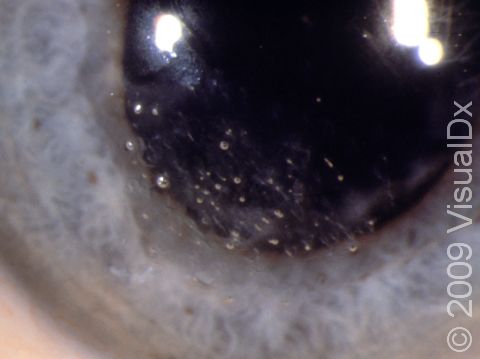Recurrent Corneal Erosion
Recurrent corneal erosion is a painful condition where the outermost layer of the eye, the epithelium, breaks down. It most commonly happens early in the morning, upon waking. The person will often feel sharp pain in the affected eye, followed by feeling like there is something stuck in the eye, redness, sensitivity to light, and tearing, which may last from minutes to hours. The erosions can happen regularly (eg, daily, weekly) or randomly.
Who's At Risk?
People who are at highest risk of recurrent corneal erosion are those who have had a previous corneal abrasion or other injury to the eye. People who have an abnormal structure to the corneal epithelium (called map-dot-fingerprint dystrophy) are also at much greater risk of poor healing following a corneal abrasion and, thus, can develop recurrent corneal erosion. People with certain underlying corneal diseases are also at higher risk for recurrent corneal erosion.
Signs & Symptoms
It is nearly impossible to see a recurrent corneal erosion with the naked eye. What usually indicates this condition is the time course coupled with certain symptoms. In recurrent corneal erosion, you may have had a corneal abrasion relatively recently (usually within the past 3-10 days) and then, usually when first opening the eye in the morning, you will feel a sudden burst of pain accompanied by symptoms of a corneal abrasion:
- Lots of watery tearing
- Sensitivity to light (especially bright light)
- Blurry vision
- Redness of the eye
- Spasm of the muscles surrounding the eye resulting in squinting
- Feeling that something is in the eye
- Ongoing pain
Self-Care Guidelines
Self-care for recurrent corneal erosion includes:
- Keeping the eye shut.
- Never rubbing the involved eye at any time (even if it feels fine).
- If wearing contact lenses, immediately removing the contact lens from the affected eye.
- Using artificial tears to bathe the eye.
- Rinsing the eye with clean water.
- Wearing sunglasses to reduce light sensitivity.
An important part of self-care for recurrent corneal erosion involves carefully opening your eyes when awakening. Upon waking, the friction of the lid against the affected cornea is enough to rip off a piece of the corneal epithelium. So if you have recurrent corneal erosion or suspect you do, upon waking, keep the affected eye closed firmly and first only open your good eye. Look around with the affected eye still closed to lubricate the eye so that when you do open it, there is less friction.
Note that unless there is an ongoing underlying corneal disease, most individuals with recurrent corneal erosion will heal completely with no vison loss and no more episodes, although it will take time (potentially weeks to years).
Treatments
If there is an underlying corneal disease requiring treatment, the eye care professional will treat the disease as appropriate. In most cases, treatment includes lubricants for the eye such as artificial tears that can be used throughout the day and ointment used at bedtime. If these therapies do not resolve the issue, the eye care professional may perform treatment, such as laser treatment, that will create a stronger bond in the area of the eye, allowing the eye to heal and reduce the erosions.
Visit Urgency
Seek medical advice for recurrent corneal erosions when:
- The pain persists beyond the first day or the pain is increasing despite self-care.
- There is no improvement with self-care after 24 hours.
- There is progressive vision loss.
- You develop pus-like discharge from the eye.
Trusted Links
References
Al-Maskari A, Larkin DP. Cornea. In: Riordan-Eva P, Augsburger JJ, eds. Vaughan & Asbury’s General Ophthalmology. 19th ed. New York, NY: McGraw-Hill Education; 2017.
Chang V, Bunya VY, Arciniega DE. Recurrent corneal erosion. American Academy of Ophthalmology. https://eyewiki.aao.org/Recurrent_Corneal_Erosion. Updated 2023 May 29.
Last modified on January 30th, 2024 at 3:43 pm

Not sure what to look for?
Try our new Rash and Skin Condition Finder



